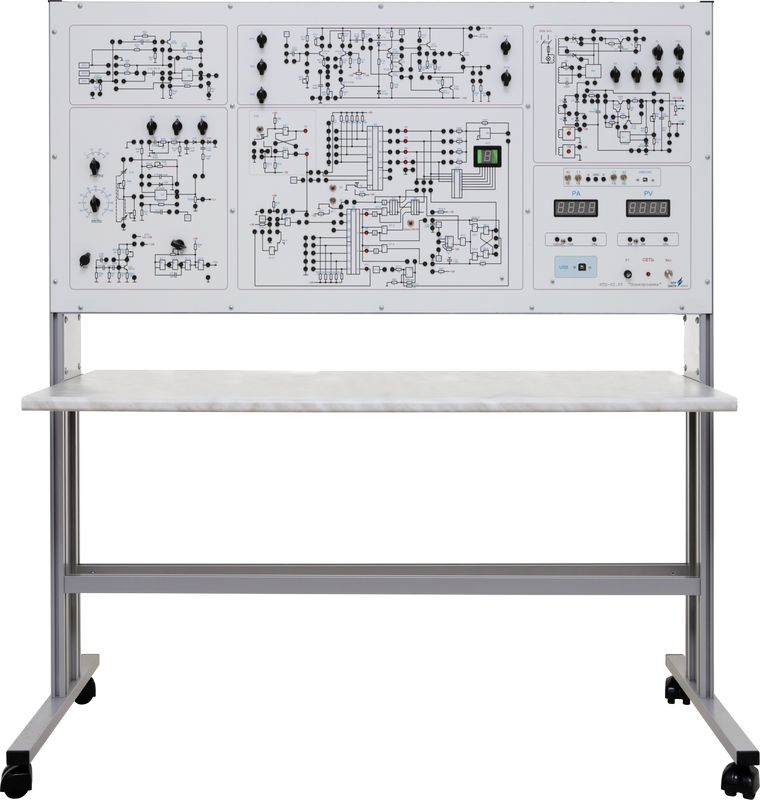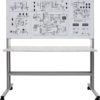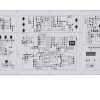NTC-02.05 “Electronics”
Br0.00
The training laboratory bench is designed for laboratory work in “Electronics” at universities and secondary educational institutions.
- Description
- Experiments provided
- Technical specifications
- Scope of delivery
- Additional equipment (specified when ordering)
Has two h/w versions: full size bench top version and table version.
The following equipment is located inside:
- power supply unit +12 V 0,5 А, -12 V 0,5 А, +5 V 0,5 А;
- operational amplifier board;
- transistor amplifier board;
- controlled thyristor rectifier board;
- generator board;
- logical element board;
- dual-channel USB oscilloscope;
- pointer instruments:
– DC ammeter (measurement range 1/250mA, accuracy class 1,5) 1 pc.;
– DC/AC voltmeter (measurement range ~25/~50 and -10/50 V, accuracy class 1,5) 1 pc.
On the front panel the wiring diagrams of studied objects are depicted. All the circuits depicted on the panel are divided into groups in accordance with the theme of work done. There are also switching jacks, pointer instruments, switchgear, and controls allowing students to change the parameters of the elements during the laboratory work.
Functionally the front panel is divided into 6 units:
- Power supply unit. The unit enables the study of potentiometric stabilizer, the influence of various passive RC- and LC-filters and active on bipolar transistor on the power supply output voltage, thyristor rectifier.
- Unit for the study of circuits on bipolar transistors. The unit allows students to investigate the classical types of amplifiers: single stage (common emitter), differential, power amplifier and emitter follower (common collector). All circuits are parts of the power amplifier circuit. The input signal is the output signal of RC-oscillator to the operational amplifier with Wien bridge. The supply voltage can be stabilized 12V and adjustable in the range 0 ÷ 16 V.
- Unit for the study of circuits on the basis of operational amplifier. The unit allows students to investigate the standard amplification circuit (inverting and non-inverting amplifier), repeater, summation, differentiation, integration, comparison (comparator), Schmitt trigger. The input signals can be: a constant signal from a controlled voltage source or a signal from RC-oscillator to operational amplifier.
- Unit for the study of signal generators. The unit allows students to investigate: RC-generator on bipolar transistor, RC-oscillator on operational amplifier with Wien bridge, with and without AGC, multivibrator on operational amplifier, start-stop multivibrator on operational amplifier, RC-oscillator on logic elements.
- Unit for the study of digital technology circuits. The unit allows students to investigate: NOT, NAND, AND gates, synchronous RS-flip-flop, D-flip-flop, JK-flip-flop, T-flip-flop on gates, integral circuits of registers, counters and decoders, DAC with resistor matrix, ADC of successive approximation.
- Unit of digital measurement system.
To carry out the work it’s necessary to assemble the circuit of the studied object using standardized jumpers, which allow students to assemble the circuits without loss of clarity.
Measurements are conducted by means of pointer instruments (ammeter and voltmeter) and dual-channel USB oscilloscope.There are special input sockets of the integrated dual-channel USB oscilloscope on the panel, which allow you to capture oscilloscope charts from the control point signals.
The laboratory stand is supplied with:
- testing program for student admission to the laboratory work. Knowledge of theory and work content is checked in the process of testing. Consequently, the student gets a mark;
- a set of teaching materials and technical documentation intended for the teaching staff.
Experiments provided
- Study of single-phase uncontrolled and controlled rectifiers:
- Studying a single-cycle uncontrolled rectifier.
- Study of a full-wave uncontrolled rectifier.
- Controlled Rectifier.
- Studying the ripple filters.
- Study of the passive C-filter.
- Study of the passive RC filter.
- Study of the active filter.
- Study of compensation voltage stabilizers.
- Studying the typical transistor switching circuits:
- Investigation of an amplifier with a common emitter (CE).
- Study of the emitter follower (repeater).
- Study of a differential amplifying stage based on bipolar transistors.
- Studying the circuits of push-pull power amplifiers.
- Studying the operational amplifier:
- Studying the characteristics of an inverting amplifier.
- Investigation of the characteristics of a non-inverting amplifier.
- Linear computing circuits based on op-amps:
- Study of the adder circuit on the op-amp.
- Study of the subtractive amplifier circuit on the op-amp.
- Study of the integrator circuit on the op-amp.
- The study of the differentiator circuit on the op-amp.
- Investigation of the analog comparator and Schmitt trigger:
- Study of the comparator circuit on the op-amp.
- Study of the Schmidt trigger on the OS.
- Studying the self-oscillators of harmonic oscillations:
- Investigation of circuit of RC-generator on bipolar transistor.
- Study of the oscillator with Wien’s bridge with and without AGC.
- Studying the multivibrators on op-amp.
- Studying the typical logic elements.
- Studying the triggers on logical elements:
- Investigation of the RS-flip-flop circuit on logical elements.
- Investigation of the circuit of a synchronous RS flip-flop on logical elements.
- Study of the T-flip-flop circuit on logical elements.
- Study of registers in integrated version.
- Pulse counter and decoders:
- Study of integrated counter circuits.
- Study of decoder circuits in integrated version.
- Studying the digital-to-analog converters.
- Studying the analog-to-digital converters.
Technical specifications
| Power supply | ~220V, 50Hz | |
| Power consumption, kW, max | 0,15 | |
| Stand overall dimensions, max: | ||
| Width, mm | 1310 | |
| Height, mm | 1470 | |
| Depth, mm | 610 | |
| Weight, kg, max | 80 | |
| Desktop version overall dimensions, max: | ||
| Width, mm | 1310 | |
| Height, mm | 680 | |
| Depth, mm | 600 | |
| Weight, kg, max | 65 | |
Scope of delivery
- training laboratory bench – 1 pc.;
- passport – 1 pc.;
- supplementary materials in electronic format – 1 pc.;
- oscilloscope – 1 pc.;
- set of jumpers.
Additional equipment (specified when ordering)
Necessary additional equipment:
Recommended additional equipment:
 Русский
Русский



